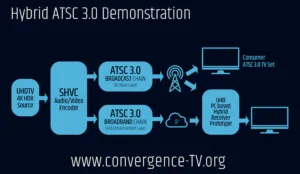
This was a very uneven week in balance between the Large and Mobile Display Monitor. LDM this week has two event reports (NAB and ProLight and Sound), while MDM is a bit thinner than I like. Never mind – things usually balance up, over time!
I didn’t get to NAB, but Chris struggled through a dose of flu to take it in. Aldo also wrote about the developments in the ATSC 3.0 broadcast standard and included an intriguing report of a project in France that is using an enhancement layer, provided over the internet to provide the data to upgrade a FullHD DVB-T2 signal to UltraHD. The system has the advantage of a good ‘fall back’ if the internet connection fails for some reason, with signalling allowing the receiver to drop back into a scaling mode.
The system is significant in France, as plenty of viewers still rely on terrestrial broadcast and don’t want to sacrifice channels for more resolution. The spectrum allocation also means that the spectrum for terrestrial TV won’t increase. On the other hand, OTT streaming, especially for live events, has had a lot of issues. I don’t have a good report or data on the problem, but anecdotally, I have heard frequently at IBC and other events that big live events such as concerts have suffered badly and couldn’t cope with really high demand.
We’ve reported previously that some ESPN content is now available via Roku and the strength of the OTT providers (Amazon said this week that it has 100 million Prime customers – and I nearly added to that, this week. Only my very negative views on Amazon’s tax, or lack of tax, policies stopped me). However, so far, they haven’t been in live sport or really big events. Eventually, though, they will have all they can get from SVOD and other non-sports.
Amazon was widely rumoured to be in discussions about Premiere League Soccer is also reported this week to have done a deal for US Open Tennis for the UK rights. It already has the rights to the ATP World Tour, where I read that it outbid Sky.
Of course, Amazon and Netflix don’t provide the infrastructure, but they depend on it. Customers are not going to keep renewing subscriptions if the service is not good enough.
Of course, the idea of enhancement could be helpful as a way of enabling 8K on top of a basic 4K signal. Or, the extra bits for HDR, HFR and WCG could be added over the internet. Meanwhile, a core DTT, satellite or cable signal which has very high reliability, can provide the core. The real challenge for the concept is that each of the camps is deeply embedded in a particular method of delivery, at the moment.

